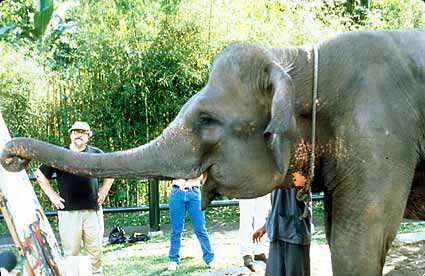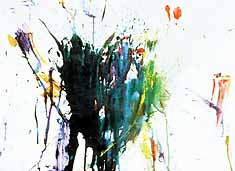
Arum,
an Asian elephant, at the canvas in Bali. Photo courtesy Goldie Paley
Gallery |
Russian conceptual
artists known for elephant art project spending spring semester at UC
Berkeley
25 March 2002
Michele
Rabkin, Consortium for the Arts
BERKELEY
-Two conceptual Russian artists known for teaching elephants to paint
and chimpanzees to use cameras are spending spring semester at the University
of California, Berkeley, instructing students about animal creativity,
totalitarianism and underground art.
Now residents
of New York City, Vitaly Komar and Alex Melamid made a name for themselves
in the 1960s as young artists and dissidents at government schools in
Soviet Russia. Their wide and often controversial range of work includes
painting, performance, installation and advertising.
 |

This
painting is by Nanchok, an Asian elephant. Photo courtesy Goldie Paley
Gallery
|
In 1998, they made
headlines for creating the Asian Elephant Art and Conservation Project,
recently featured on "60 Minutes." Komar and Melamid teach
elephants that once worked in Thailand's logging industry to paint,
then sell the paintings to raise money for the animals' care.
At UC Berkeley, the
artists are in residencies sponsored by the UC Berkeley Consortium for
the Arts, the Arts Research Council and the Department of Art Practice.
"The students
are having a delightful, robust, even controversial adventure with the
Russian team," said Mary Lovelace O'Beal, chair of art practice.
The artists are displaying
their elephant paintings, giving guest lectures in Slavic Studies about
totalitarianism, and will visit a biology class in April to talk about,
among other things, how they taught chimps to take photographs.
In one recent class,
students spent the session talking about performance art versus the "happenings"
of the 1960s, freedom of expression, being a spectator compared to a
participant, cloning Dali, and the changing public perceptions that affect
an artist's reputation.
Komar said their
art practice students have each been assigned to invent an artist –
a sort of hero or alter ego with no limitations. They will develop a
biography of this artist. One student is composing a whole new artistic
movement. The plan is to assemble their work in a book that they hope
to publish, and possibly display in New York City.
Reflecting on the
Asian elephant project, Komar said he and Melamid first began working
with elephants in zoos in the United States, teaching them to paint,
and also worked with chimps and cameras. But after reading about the
plight of elephants in Thailand, who fell on hard times after logging
was banned in 1990, they were drawn to help.
The project involves
draping animals in aprons and teaching them to paint wielding a brush
with their trunks. The resulting artwork, which resembles abstract expressionist
work, is auctioned, with a percentage of funds going toward proper care
for the elephants and support for their trainers. Some elephant paintings
have sold for up to $2,000.
"You have
to see this project as complexly related to the now common cry that painting
is dead and artists have gone on to other things," said Charles
Altieri, a professor of English at UC Berkeley and director of the Consortium
of the Arts. "What can we do with a dead art?
"Maybe we
can make it a live form of social intervention — in this case by
saving Thai elephants from destruction and actually making money for
a good cause. After all, it is arguable that what killed painting was
the gallery structure that created ridiculous myths and produced prices
for art that only the very few could afford. It is a nice irony that
what was ruined by profit motive can be restored as a kind of charity."
Modern art was
based in large part on the idea that art should have no practical purpose,
so artistic energies and development of materials could be appreciated
for their own sake. "What better way to celebrate the demise of
this modernist ideal than to develop a mode of painting that serves clear
and valuable social ends, without needing any rhetoric that it improves
anyone's soul," said Altieri.
He added that this
elephant art raises serious questions about what is art, why people collect,
and how we can link talk about the unconscious in art to the forms of
gesture that elephants produce on canvas. The more seriously we are tempted
to take these elephant paintings, the more ridiculous we are likely to
feel speaking about deep psychological meanings in all non-figurative
expressive work.
"And that I
think is their (Komar's and Melamid's) ultimate point,"
Altieri said. "They want us to wonder if there might be something
very odd and very wrong about the way that the high culture art industries
go about their work. But we also have to recognize that there is also
something very right about the possibility that this world is sufficiently
generous to give air time to elephants and apparently mad but brilliant
émigré artists."
Komar said when he
and Melamid finish their residency they will return to Thailand to continue
the elephant project. In November, they open a show in New York City
about spirituality in art. They also are contemplating a project involving
beaver architecture.
Meanwhile, at the
Berkeley Art Museum's Gallery 3, more than 50 paintings done by
16 Thai elephants will be on display, along with photos and documentation,
from April 10 through July 14.
A slide show lecture
by the artists about their elephant work and a screening of "The
People's Painting" video will take place at the Berkeley Art
Museum Theater at 5:30 p.m., Thursday, April 11. The film is a Komar-Melamid
project using information assembled from polls, focus groups and a road
trip through Great Britain to create a picture that would produce what
most people project as the painted images they most desire.
Additional information:
|